Timing and Effect of the Hidden Thrust Fault on the Tight Reservoir in the Southeastern Sichuan Basin
Abstract
1. Introduction
2. Geological Setting
3. Data and Methods
4. Results
4.1. Characteristics of the Thrust Fault
4.2. Fracture Diagenesis
4.3. Characteristics of the Fractured Reservoir
4.4. U–Pb Ages of the Fracture Cements
5. Discussion
5.1. Timing of Hidden Fault Activity
5.2. The Fault Effect on the Reservoir
6. Conclusions
- (1)
- Three sets of thrust faults are identified in the Permian of the southeastern Sichuan Basin based on seismic interpretation. The NE-trending faults exhibit inherited activity that extends to the surface, while the EW- and NW-trending hidden faults propagate upward from the Upper Permian into the Lower Triassic. Fault inversion is recognized through thickness variations between fault walls.
- (2)
- In situ U–Pb dating of fracture cements yields ages of 247.4 ± 2 Ma and 234.8 ± 9.1 Ma, indicating that hidden faulting predated the Early Triassic. Combined evidence from stratigraphic omission, structural uplift, and fault inversion suggests that thrust faulting initiated at the end of the Middle Permian.
- (3)
- Contemporaneous fracturing during the Late Permian was crucial for the development of fracture–cavity reservoirs at the top of the Middle Permian unconformity. These fracture–cavity systems along thrust fault damage zones constitute the principal targets for high gas production.
- (4)
- This study establishes a new temporal framework for deep hidden faults and provides key insights into the tectonic evolution and reservoir development of the southeastern Sichuan Basin.
Author Contributions
Funding
Data Availability Statement
Acknowledgments
Conflicts of Interest
References
- Caine, J.S.; Evans, J.P.; Forster, C.B. Fault zone architecture and permeability structure. Geology 1996, 24, 1025–1028. [Google Scholar] [CrossRef]
- Collettini, C.; Niemeijer, A.; Viti, C.; Marone, C. Fault zone fabric and fault weakness. Nature 2009, 462, 907–910. [Google Scholar] [CrossRef] [PubMed]
- Bense, V.F.; Gleeson, T.; Loveless, S.E.; Bour, O.; Scibek, J. Fault zone hydrogeology. Earth-Sci. Rev. 2013, 127, 171–192. [Google Scholar] [CrossRef]
- Fossen, H. Structural Geology; Cambridge University Press: Cambridge, UK, 2010. [Google Scholar]
- Bardot, K.; Lesueur, M.; Siade, A.J.; Lang, S.C.; McCallum, J.L. Structural uncertainty due to fault timing: A multimodel case study from the Perth Basin. Groundwater 2024, 63, 41–51. [Google Scholar] [CrossRef]
- Yang, H.J.; Wu, G.H.; Han, J.F.; Su, Z. Structural Analysis of Strike-Slip Faults in the Tarim Basin. Chin. J. Geol. 2020, 55, 1–16. (In Chinese) [Google Scholar] [CrossRef]
- Zuccari, C.; Mazzarini, F.; Tavarnelli, E.; Viola, G.; Aldega, L.; Moretto, V.; Xie, R.; Musumeci, G. How brittle detachments form and evolve through space and time. Earth Planet. Sci. Lett. 2024, 648, 119108. [Google Scholar] [CrossRef]
- Curzi, M.; Viola, G.; Zuccari, C.; Aldega, L.; Billi, A.; Van Der Lelij, R.; Kylander-Clark, A.; Vignaroli, G. Tectonic evolution of the Eastern Southern Alps (Italy): A reappraisal from new structural data and geochronological constraints. Tectonics 2024, 43, 008013. [Google Scholar] [CrossRef]
- Del Sole, L.; Viola, G.; Aldega, L.; Moretto, V.; Curzi, M.; Xie, R.; Cantelli, L.; Vignaroli, G. High-resolution investigations of fault architecture in space and time. Sci. Rep. 2025, 15, 2258. [Google Scholar] [CrossRef]
- Roberts, N.M.W.; Walker, R.J. U-Pb geochronology of calcite-mineralized faults: Absolute timing of rift-related fault events on the northeast Atlantic margin. Geology 2016, 44, 531–534. [Google Scholar] [CrossRef]
- Godeau, N.; Deschamps, P.; Guihou, A.; Leonide, P.; Tendil, A.; Gerdes, A.; Hamelin, B.; Girard, J.P. U-Pb dating of calcite cement and diagenetic history in microporous carbonate reservoirs: Case of the Urgonian Limestone, France. Geology 2018, 46, 247–250. [Google Scholar] [CrossRef]
- Parrish, R.R.; Parrish, C.M.; Lasalle, S. Vein calcite dating reveals Pyrenean orogeny as cause of Paleogene deformation in southern England. J. Geol. Soc. 2018, 175, 425–442. [Google Scholar] [CrossRef]
- Nuriel, P.; Wotzlaw, J.F.; Ovtcharova, M.; Vaks, A.; Stremtan, C.; Šala, M.; Roberts, N.M.W.; Kylander-Clark, A.R.C. The use of ASH-15 flowstone as a matrix-matched reference material for laser-ablation U Pb geochronology of calcite. Geochronology 2021, 3, 35–47. [Google Scholar] [CrossRef]
- Yang, P.; Wu, G.H.; Nurield, P.; Nguyen, A.D.; Chen, Y.Q.; Yang, S.; Feng, Y.X.; Ren, Z.L.; Zhao, J.X. In situ LA-ICPMS U-Pb dating and geochemical characterization of fault-zone calcite in the central Tarim Basin, northwest China: Implications for fluid circulation and fault reactivation. Chem. Geol. 2021, 568, 120125. [Google Scholar] [CrossRef]
- Xu, M.L.; Yang, Y.B.; Sun, C.Y.; Qiu, G.E.; Chen, L.; Jing, L. Geophysical characterisation and oil–gas resource analysis of the southern Huaying Mountain Fault Zone, Sichuan Basin, China. Minerals 2023, 13, 270. [Google Scholar] [CrossRef]
- Li, Z.; Zhang, Z.P.; Li, S.J.; Xia, W.Q. Characteristics of fault systems and their reservoir control in the Qijiang area of southeastern Sichuan Basin. Nat. Gas Geosci. 2024, 35, 1999–2011. [Google Scholar]
- Yan, D.P.; Wang, X.W.; Liu, Y.Y. Analysis of fold style and its formation mechanism in the area of boundary among Sichuan, Hubei and Hunan. Geoscience 2000, 14, 17–43. [Google Scholar]
- Li, C.X.; He, D.F.; Lu, G.; Wen, K.; Simon, A.; Sun, Y.P. Multiple thrust detachments and their implications for hydrocarbon accumulation in the northeastern Sichuan Basin, southwestern China. AAPG Bull. 2021, 105, 357–390. [Google Scholar] [CrossRef]
- Yang, G.; Chen, Z.X.; Wang, X.B. Double wedged-shaped structures of the Mingyuexia anticline in eastern Sichuan thrust belt, South China. Geolo. Rev. 2021, 67, 901–916, (In Chinese with English abstract). [Google Scholar]
- Shen, C.B.; Mei, L.F.; Xu, S.H. Fission track dating of Mesozoic sandstones and its tectonic significance in the Eastern Sichuan Basin, China. Radiat. Meas. 2009, 44, 945–949. [Google Scholar] [CrossRef]
- Deng, B.; Liu, S.G.; Li, Z.W.; Jansa, L.F.; Liu, S.; Wang, G.Z.; Sun, W. Differential exhumation at eastern margin of the Tibetan Plateau, from apatite fission-track thermochronology. Tectonophysics 2013, 591, 98–115. [Google Scholar] [CrossRef]
- Tian, Y.T.; Qiu, N.S.; Kohn, B.P.; Zhu, C.Q.; Hu, S.B.; Gleadow, A.J.W.; McInnes, B.I.A. Detrital zircon (U—Th)/He thermochronometry of the Mesozoic Daba Shan Foreland Basin, central China: Evidence for timing of post-orogenic denudation. Tectonophysics 2012, 570–571, 65–77. [Google Scholar] [CrossRef]
- Cao, Y.; Xu, Q.; Zheng, J.F.; Tan, X.C.; Li, M.L.; Stephen, K.; Li, L.; Qiu, Y.C.; Deng, W. Two stages of Late Cretaceous to Neogene deformation of the Huayingshan tectonic belt, eastern Sichuan Basin, SW China. J. Asian Earth Sci. 2023, 255, 105779. [Google Scholar] [CrossRef]
- Liu, S.G.; Yang, Y.; Deng, B.; Zhong, Y.; Wen, L.; Sun, W.; Li, Z.W.; Jansa, L.; Li, J.X.; Song, J.M.; et al. Tectonic evolution of the Sichuan Basin, Southwest China. Earth-Sci. Rev. 2021, 213, 103470. [Google Scholar] [CrossRef]
- Xiao, D.; Tan, X.C.; Xi, A.H.; Liu, H.; Shan, S.J.; Xia, J.W.; Cheng, Y.; Lian, C.B. An inland facies-controlled eogenetic karst of the carbonate reservoir in the Middle Permian Maokou Formation, southern Sichuan Basin, SW China. Mar. Pet. Geol. 2016, 72, 218–233. [Google Scholar] [CrossRef]
- Huang, S.P.; Jiang, Q.C.; Feng, Q.F.; Wu, Y.; Lu, W.H.; Su, W.; Chen, X.Y.; Ren, M.Y.; Peng, H. Type and distribution of Mid-Permian Maokou Formation karst reservoirs in southern Sichuan Basin, SW China. Pet. Explor. Dev. 2019, 46, 293–300. [Google Scholar] [CrossRef]
- Zhu, D.C.; Zou, H.Y.; Yang, M.L.; Li, T.; Li, T.; Li, H.P.; Xu, L.; Wen, L.; Zhou, G. The Middle Permian Maokou reservoir (southern Sichuan Basin, China): Controls on karst development and distribution. J. Pet. Sci. Eng. 2021, 204, 108686. [Google Scholar] [CrossRef]
- Huang, H.; Huyskens, M.H.; Yin, Q.Z.; Cawood, P.A.; Hou, M.C.; Yang, J.H.; Xiong, F.H.; Du, Y.S.; Yang, C.C. Eruptive tempo of Emeishan large igneous province, southwestern China and northern Vietnam: Relations to biotic crises and paleoclimate changes around the Guadalupian-Lopingian boundary. Geology 2022, 50, 1083–1087. [Google Scholar] [CrossRef]
- Liu, J.W.; Wu, G.H.; Li, H.; Zhang, W.J.; Zheng, M.J.; Long, L.; Li, C.H.; Deng, M. Identification of strike-slip faults and their control on the Permian Maokou gas reservoir in the southern Sichuan Basin (SW China): Fault intersections as hydrocarbon enrichment zones. Energies 2024, 17, 246438. [Google Scholar] [CrossRef]
- Li, H.; Liu, J.W.; Zheng, M.J.; Li, S.Y.; Long, H.; Li, C.H.; Huang, X.R. The seismic identification of small strike-slip faults in the deep Sichuan basin (SW China). Processes 2024, 12, 071508. [Google Scholar] [CrossRef]
- Hill, C.A.; Polyak, V.J.; Asmerom, Y.; Provencio, P.P. Constraints on a Late Cretaceous uplift, denudation, and incision of the Grand Canyon region, southwestern Colorado Plateau, USA, from U-Pb dating of lacustrine limestone. Tectonics 2016, 35, 896–906. [Google Scholar] [CrossRef]
- Li, T.; Zhu, D.C.; Yang, M.L.; Zhang, X.H.; Li, P.P.; Lu, C.J.; Zou, H.Y. Early-stage marine dolomite altered by hydro-thermal fluids in the Middle Permian Maokou Formation in the eastern Sichuan Basin, Southern China. Mar. Pet. Geol. 2021, 134, 105367. [Google Scholar] [CrossRef]
- Salih, N.; Mansurbeg, H.; Kolo, K.; Gerdes, A.; Préat, A. In situ U-Pb dating of hydrothermal diagenesis in tectonically controlled fracturing in the Upper Cretaceous Bekhme Formation, Kurdistan Region-Iraq. Int. Geol. Rev. 2020, 62, 2261–2279. [Google Scholar] [CrossRef]
- Palacios-García, N.B.; Fitz-Díaz, E.; Stockli, L.D.; Stockli, D.F. U–Pb calcite dating of brittle deformation in Permian carbonates within the Chicomuselo fold and thrust belt, SE Mexico. J. Struct. Geol. 2023, 171, 104863. [Google Scholar] [CrossRef]
- Ma, B.S.; Wu, G.H.; Zhang, Y.T.; Scarselli, N.; Yang, B.; Jiang, Y.K.; Yao, J.; Zhao, X.X.; Yang, M.C.; Wang, J. New constraints from in-situ U-Pb ages and fluid inclusions of calcite cement and structural analysis on multiple stages of strike-slip fault activities in the northern Tarim Basin, NW China. J. Asian Earth Sci. 2024, 273, 106246. [Google Scholar] [CrossRef]
- Wang, R.J.; Yang, J.P.; Chang, L.J.; Zhang, Y.T.; Sun, C.; Wan, X.G.; Wu, G.H.; Bai, B.C. 3D modeling of fracture-cave reservoir from a strike-slip fault-controlled carbonate oilfield in northwestern China. Energies 2022, 15, 176415. [Google Scholar] [CrossRef]
- Wang, S.L.; Chen, L.X.; Su, Z.; Dong, H.Q.; Ma, B.S.; Zhao, B.; Lu, Z.D.; Zhang, M. Differential characteristics of conjugate strike-slip faults and their controls on fracture-cave reservoirs in the Halahatang area of the northern Tarim Basin, NW China. Minerals 2024, 14, 070688. [Google Scholar] [CrossRef]
- Wang, J.; Wang, X.T.; Cao, Y.C.; Hao, F.; Pang, Y.H.; Yun, L.; Yang, H.J.; Xie, M.F. Characteristics and origin of the ultradeep Ordovician fault-karst reservoirs: An example from the Shunbei-Yuejin area, Tarim Basin. AAPG Bull. 2024, 108, 1231–1260. [Google Scholar] [CrossRef]

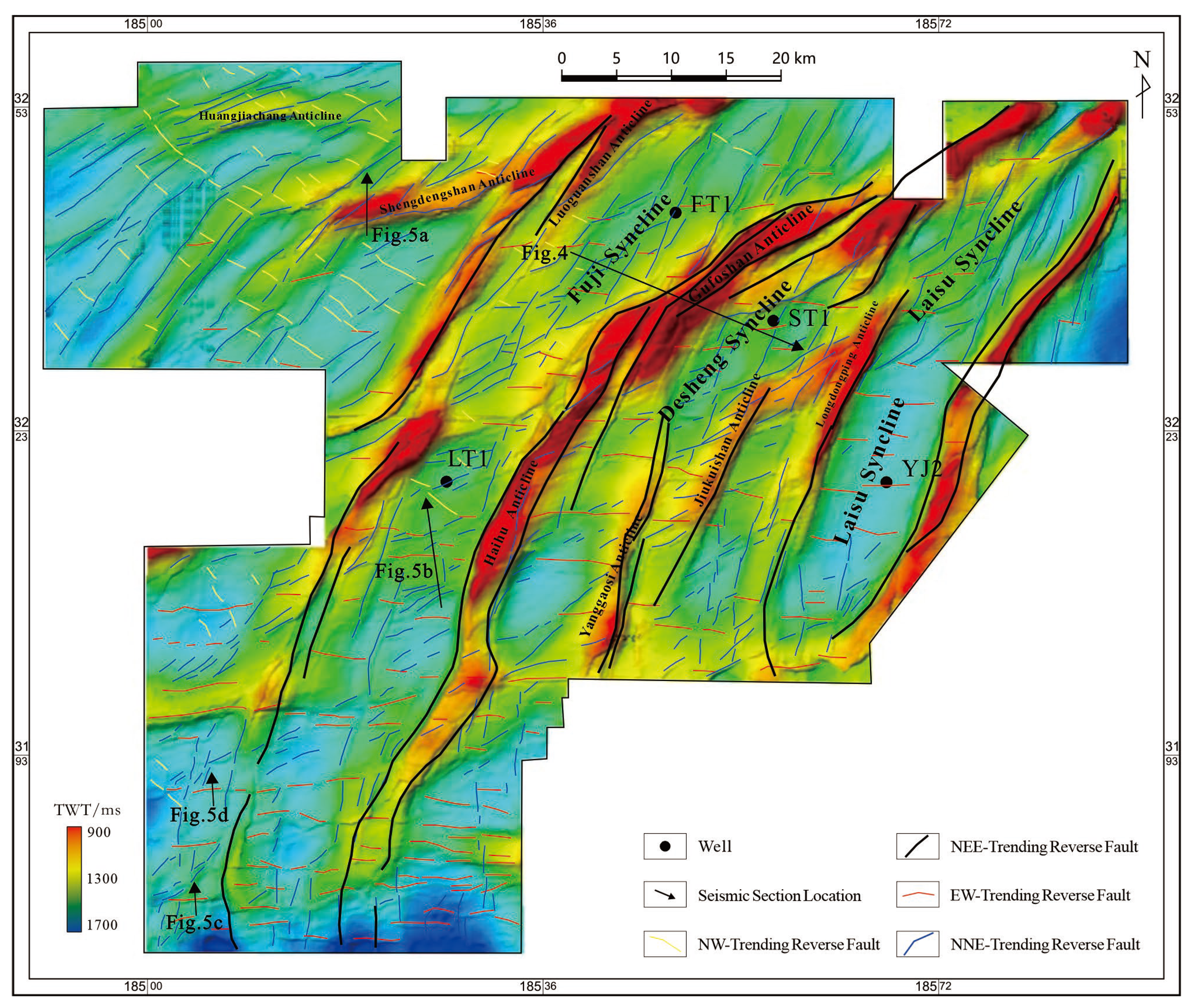
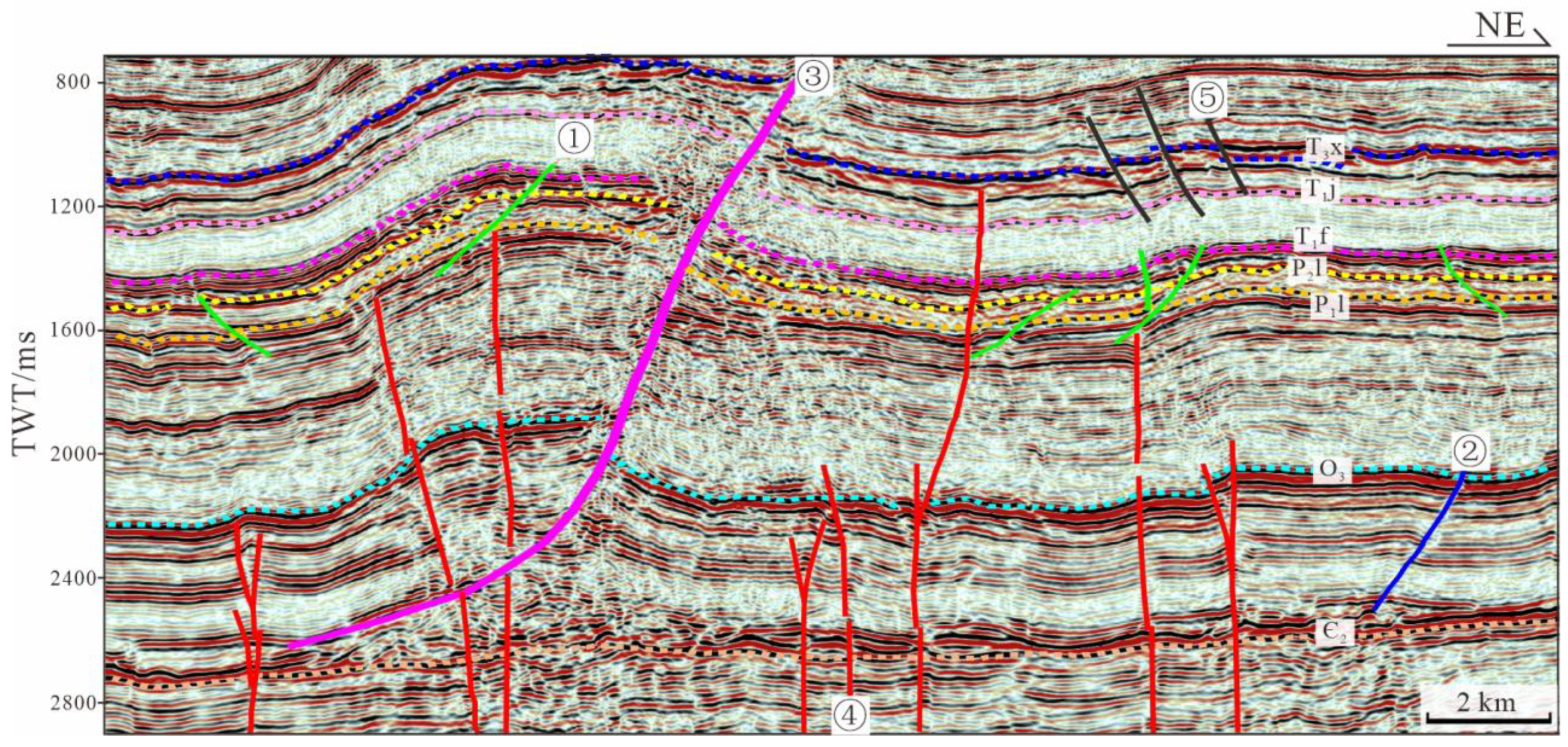
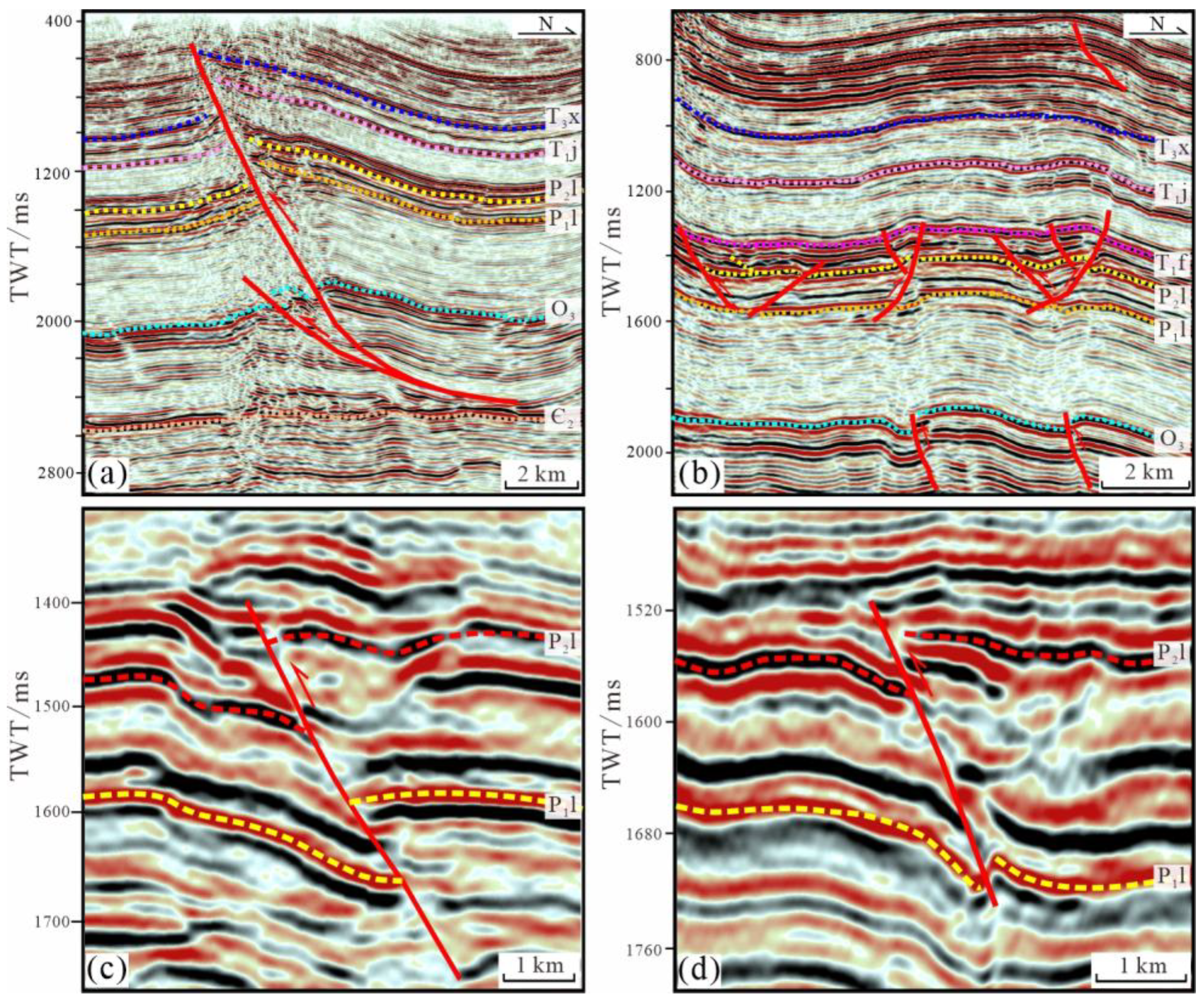
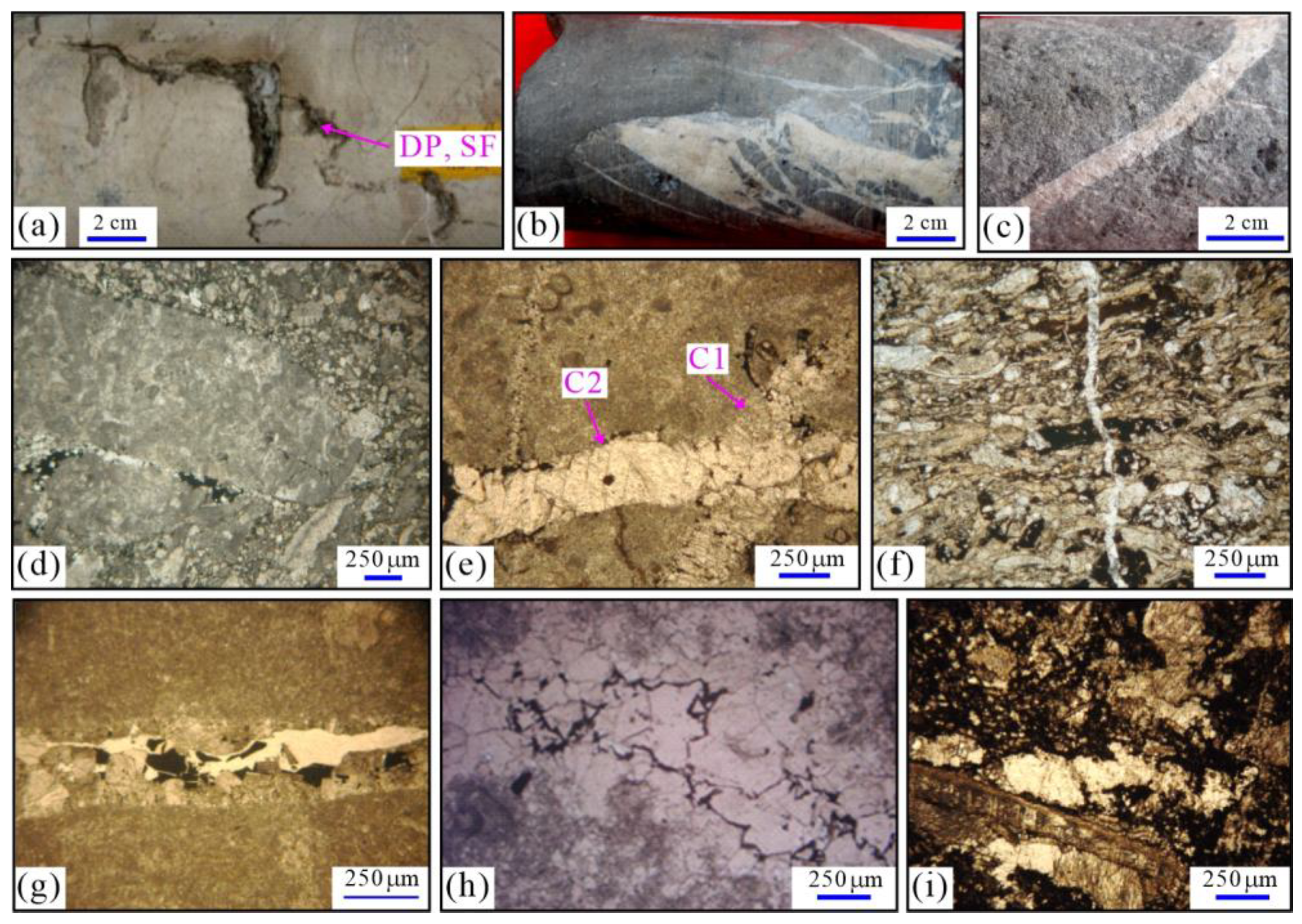

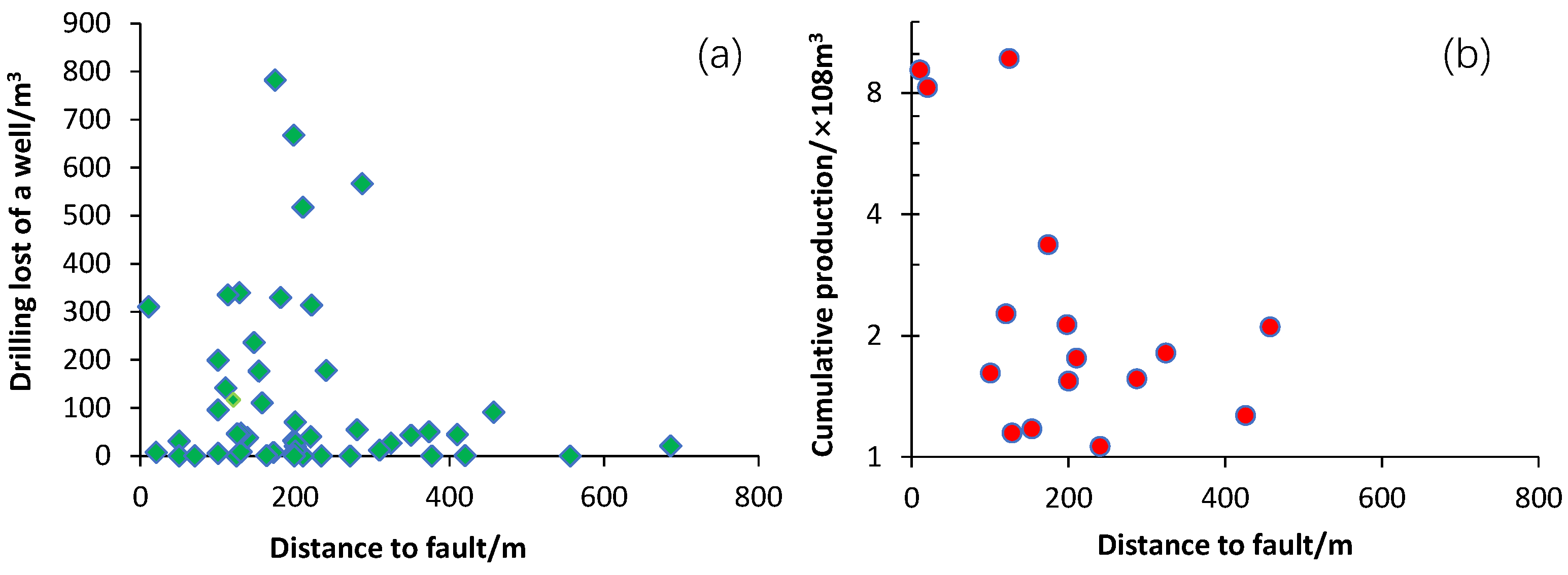
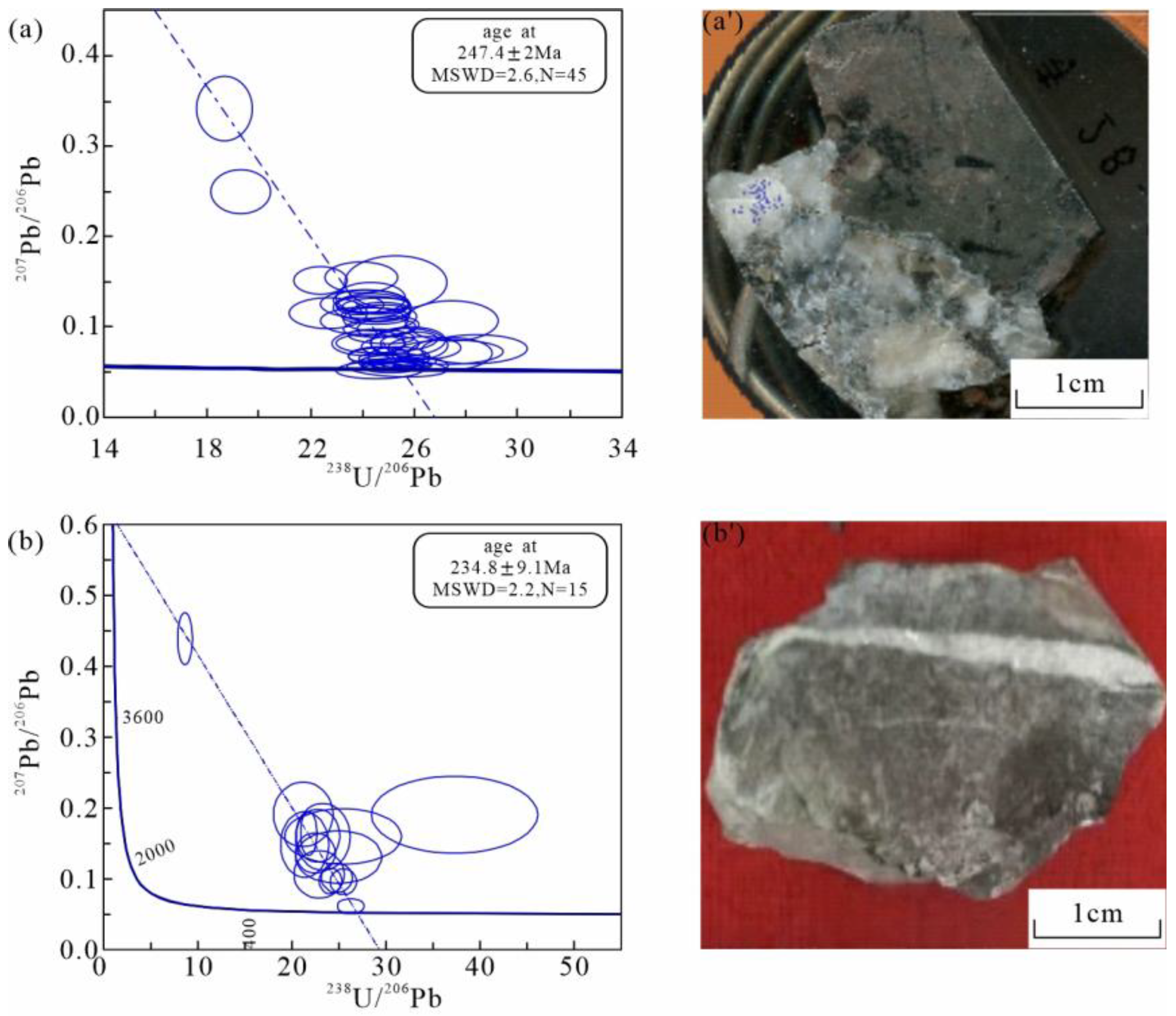

Disclaimer/Publisher’s Note: The statements, opinions and data contained in all publications are solely those of the individual author(s) and contributor(s) and not of MDPI and/or the editor(s). MDPI and/or the editor(s) disclaim responsibility for any injury to people or property resulting from any ideas, methods, instructions or products referred to in the content. |
© 2025 by the authors. Licensee MDPI, Basel, Switzerland. This article is an open access article distributed under the terms and conditions of the Creative Commons Attribution (CC BY) license (https://creativecommons.org/licenses/by/4.0/).
Share and Cite
Long, H.; Jiang, T.; Wang, J.; Tang, H.; Qiu, C.; Liu, T.; Deng, M.; Tian, W. Timing and Effect of the Hidden Thrust Fault on the Tight Reservoir in the Southeastern Sichuan Basin. Minerals 2025, 15, 1209. https://doi.org/10.3390/min15111209
Long H, Jiang T, Wang J, Tang H, Qiu C, Liu T, Deng M, Tian W. Timing and Effect of the Hidden Thrust Fault on the Tight Reservoir in the Southeastern Sichuan Basin. Minerals. 2025; 15(11):1209. https://doi.org/10.3390/min15111209
Chicago/Turabian StyleLong, Hui, Tongwen Jiang, Jiamu Wang, Hao Tang, Chen Qiu, Tian Liu, Min Deng, and Weizhen Tian. 2025. "Timing and Effect of the Hidden Thrust Fault on the Tight Reservoir in the Southeastern Sichuan Basin" Minerals 15, no. 11: 1209. https://doi.org/10.3390/min15111209
APA StyleLong, H., Jiang, T., Wang, J., Tang, H., Qiu, C., Liu, T., Deng, M., & Tian, W. (2025). Timing and Effect of the Hidden Thrust Fault on the Tight Reservoir in the Southeastern Sichuan Basin. Minerals, 15(11), 1209. https://doi.org/10.3390/min15111209





